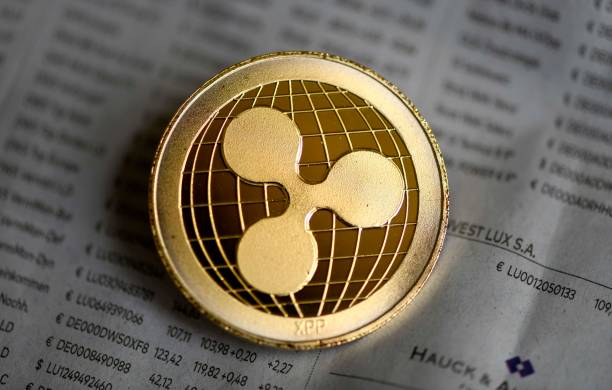Ripple reveal tokenized assets will surge to $18.9 trillion by 2033

Ripple and Boston Consulting Group (BCG) have predicted sharp growth in the tokenized real-world asset market, according to a recently released study.
The study projected RWA to rise from the current $0.6 trillion to $18.9 trillion by 2033. It forecasts that $9.4 trillion will be achieved within 2030 with a compound annual growth rate (CAGR) of 53%.
By 2033, a $0.6T → $18.9T shift is coming as tokenization reshapes global finance.
— Ripple (@Ripple) April 7, 2025
Why?
🏛️ Regulation & institutional adoption
🏙️ Real-world assets like bonds & real estate
🔀 Faster, interoperable financial infrastructure
The institutions that act now will lead the next… pic.twitter.com/RjJcACzWm2
Tokenization is the process of transforming physical assets such as real estate, bonds, and private credit into tokens. These assets are available for trading around the clock and can be divided into smaller portions.
Tibor Merey, the managing director at BCG, noted that “tokenization brings financial asset-backed features of programmability and interoperability and records them on a digital ledger.” Many large financial companies, such as BlackRock, Fidelity, and JPMorgan, have already demonstrated a high level of early adoption in this sphere.
Ripple’s senior vice president, Markus Infanger, noted that, with tokenization, assets go beyond mere holding and trading. They are embedded in useful transactional roles, and this underscores a significant trend in the industry. Some of the use cases mentioned by industry experts include tokenization of ownership of real estate, such as property sales and collateralized lending.
Regulatory clarity and strategic partnerships fuel growth
The Ripple-BCG report also identified clear regulatory frameworks within regions such as the European Union, UAE, and Switzerland as key growth factors. Furthermore, the technological infrastructure, including secure digital wallets and reliable custodians, increases market attraction. Integrated financial services between conventional banks and fintech companies are also rapidly developing.
“Tokenization is no longer just a concept—it’s the foundation for the future of global finance.”
Bernhard Kronfellner from BCG.
XRP advocate and attorney John Deaton has also recently commended Ripple CEO Brad Garlinghouse for spearheading Ripple in RWA tokenization. He also said that Garlinghouse, Coinbase CEO Brian Armstrong, and BlackRock CEO Larry Fink also agree that eventually, everything will be tokenized.
In another post on Facebook, Garlinghouse noted that tokenization is “revolutionizing finance” through improving effectiveness and accessibility.
Ripple’s active role in tokenization
Ripple has been one of the most active players in introducing the tokenization concept and launching products that reflect this idea. Recently, David Schwartz, the CTO of Ripple, backed these statements within the “Crypto in a Minute” video series.
Ripple CTO David Schwartz illustrates the efficiency gains from tokenization, https://t.co/DeUUR1Km7m pic.twitter.com/f8H0lu4NEN
— 𝗕𝗮𝗻𝗸XRP (@BankXRP) February 12, 2025
He gave real estate as an example of a tokenized asset since it simplifies ownership transfer and helps sell and collateralize home ownership. These applications not only increase usability for the end-users but also create new forms of operations with assets, trading, and protection in the real world.
XRP, Ripple’s primary cryptocurrency, is designed to solve the problems of speed and cost of cross-border transactions. As tokenization continues to occupy modern finance, XRP can serve as a great enabler for fast and inexpensive transfers of various assets.
Ripple also introduced its first stablecoin, RLUSD, an asset backed by USD. It is currently ranked at about $300 million in market cap, and the daily trading volume is nearly $150 million.
Since its launch, RLUSD has proved to be useful for a wide range of financial endeavors with the ability to be collateralized within decentralized finance (DeFi) and conventional financial sectors. Ripple said that several industries, including non-profits, have shown interest in using RLUSD, particularly for easy and efficient donations.
The recent integration of stablecoin in the Ripple payments improves cross-border treasury processing and eliminates hindrances that some of the customers, including BKK Forex and iSend, use. This strategic move reveals the company’s focus on increasing operational capabilities for large-scale customers.
Moreover, Ripple’s forward-thinking approach to tokenization reflects its strategic placement in the middle of traditional (Web2) and blockchain-native (Web3) financial systems.
Cryptopolitan Academy: Want to grow your money in 2025? Learn how to do it with DeFi in our upcoming webclass. Save Your Spot
Ripple reveal tokenized assets will surge to $18.9 trillion by 2033

Ripple and Boston Consulting Group (BCG) have predicted sharp growth in the tokenized real-world asset market, according to a recently released study.
The study projected RWA to rise from the current $0.6 trillion to $18.9 trillion by 2033. It forecasts that $9.4 trillion will be achieved within 2030 with a compound annual growth rate (CAGR) of 53%.
By 2033, a $0.6T → $18.9T shift is coming as tokenization reshapes global finance.
— Ripple (@Ripple) April 7, 2025
Why?
🏛️ Regulation & institutional adoption
🏙️ Real-world assets like bonds & real estate
🔀 Faster, interoperable financial infrastructure
The institutions that act now will lead the next… pic.twitter.com/RjJcACzWm2
Tokenization is the process of transforming physical assets such as real estate, bonds, and private credit into tokens. These assets are available for trading around the clock and can be divided into smaller portions.
Tibor Merey, the managing director at BCG, noted that “tokenization brings financial asset-backed features of programmability and interoperability and records them on a digital ledger.” Many large financial companies, such as BlackRock, Fidelity, and JPMorgan, have already demonstrated a high level of early adoption in this sphere.
Ripple’s senior vice president, Markus Infanger, noted that, with tokenization, assets go beyond mere holding and trading. They are embedded in useful transactional roles, and this underscores a significant trend in the industry. Some of the use cases mentioned by industry experts include tokenization of ownership of real estate, such as property sales and collateralized lending.
Regulatory clarity and strategic partnerships fuel growth
The Ripple-BCG report also identified clear regulatory frameworks within regions such as the European Union, UAE, and Switzerland as key growth factors. Furthermore, the technological infrastructure, including secure digital wallets and reliable custodians, increases market attraction. Integrated financial services between conventional banks and fintech companies are also rapidly developing.
“Tokenization is no longer just a concept—it’s the foundation for the future of global finance.”
Bernhard Kronfellner from BCG.
XRP advocate and attorney John Deaton has also recently commended Ripple CEO Brad Garlinghouse for spearheading Ripple in RWA tokenization. He also said that Garlinghouse, Coinbase CEO Brian Armstrong, and BlackRock CEO Larry Fink also agree that eventually, everything will be tokenized.
In another post on Facebook, Garlinghouse noted that tokenization is “revolutionizing finance” through improving effectiveness and accessibility.
Ripple’s active role in tokenization
Ripple has been one of the most active players in introducing the tokenization concept and launching products that reflect this idea. Recently, David Schwartz, the CTO of Ripple, backed these statements within the “Crypto in a Minute” video series.
Ripple CTO David Schwartz illustrates the efficiency gains from tokenization, https://t.co/DeUUR1Km7m pic.twitter.com/f8H0lu4NEN
— 𝗕𝗮𝗻𝗸XRP (@BankXRP) February 12, 2025
He gave real estate as an example of a tokenized asset since it simplifies ownership transfer and helps sell and collateralize home ownership. These applications not only increase usability for the end-users but also create new forms of operations with assets, trading, and protection in the real world.
XRP, Ripple’s primary cryptocurrency, is designed to solve the problems of speed and cost of cross-border transactions. As tokenization continues to occupy modern finance, XRP can serve as a great enabler for fast and inexpensive transfers of various assets.
Ripple also introduced its first stablecoin, RLUSD, an asset backed by USD. It is currently ranked at about $300 million in market cap, and the daily trading volume is nearly $150 million.
Since its launch, RLUSD has proved to be useful for a wide range of financial endeavors with the ability to be collateralized within decentralized finance (DeFi) and conventional financial sectors. Ripple said that several industries, including non-profits, have shown interest in using RLUSD, particularly for easy and efficient donations.
The recent integration of stablecoin in the Ripple payments improves cross-border treasury processing and eliminates hindrances that some of the customers, including BKK Forex and iSend, use. This strategic move reveals the company’s focus on increasing operational capabilities for large-scale customers.
Moreover, Ripple’s forward-thinking approach to tokenization reflects its strategic placement in the middle of traditional (Web2) and blockchain-native (Web3) financial systems.
Cryptopolitan Academy: Want to grow your money in 2025? Learn how to do it with DeFi in our upcoming webclass. Save Your Spot

